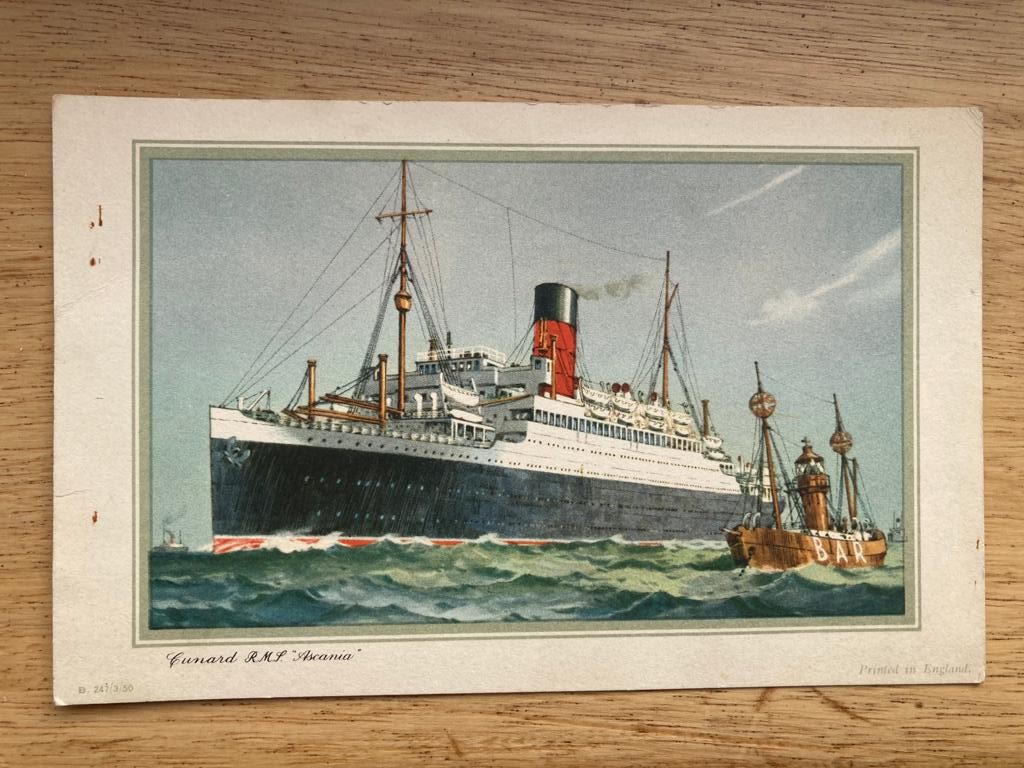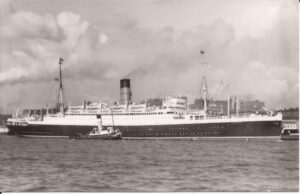 FASCINATING documents from a long-forgotten transatlantic voyage to Liverpool undertaken exactly 70 years ago were discovered by a friend while clearing out her late aunt’s flat.
FASCINATING documents from a long-forgotten transatlantic voyage to Liverpool undertaken exactly 70 years ago were discovered by a friend while clearing out her late aunt’s flat.
Providing a portal into the final throes of ocean travel’s golden age, it comprises memorabilia found by Claire Rider, a Liverpool city tour guide, from a sailing taken by her late aunt Mrs Doris Bilas (nee Rider) aboard the Cunard ocean liner RMS Ascania. She sailed from Montreal to Liverpool, down the St Lawrence River via Quebec, from 30 September to 8 October, 1953, when Liverpool was still the Heathrow of the seas.
Included among the items is this postcard ( main colour picture above) with a fine watercolour illustration of Ascania passing the much-missed Mersey Bar Light Vessel, whose successor LV Planet I believe is now in Gloucester Docks, in spite of several concerted efforts to keep her in Liverpool.
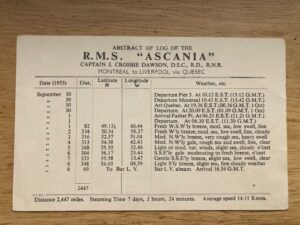 According to the Abstract of the Ship’s Log given to the passengers and kept by Mrs Bilas, Ascania (nicknamed ‘the Ash Can‘ by Cunard crews) covered the 2,447 miles in a ‘steaming time’ of seven days, five hours and 24 minutes to her berth at Princes Landing Stage Liverpool, as seen above, now Liverpool Cruise Terminal.
According to the Abstract of the Ship’s Log given to the passengers and kept by Mrs Bilas, Ascania (nicknamed ‘the Ash Can‘ by Cunard crews) covered the 2,447 miles in a ‘steaming time’ of seven days, five hours and 24 minutes to her berth at Princes Landing Stage Liverpool, as seen above, now Liverpool Cruise Terminal.
No flyer, Ascania chugged across the Atlantic at a stately average speed of 14.11 knots. While not in Cunard’s premier league of liners, she was a fine stalwart of the fleet and had a distinguished master for this voyage, Capt J Crosbie Dawson, DSC, RD, RNR, who like Ascania was a World War II veteran.
As seen in the log illustrated, the weather was initially clement, but by 3 October, there were very rough seas and a heavy swell continuing for two days.
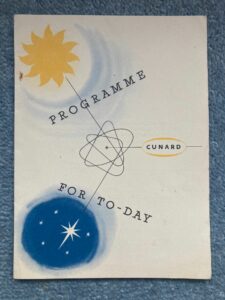 Although visibility was fine there were probably few people in the dining room or attending events. The programme’s artily attractive cover is left; anyone for the community singing at 10.30pm? The gale finally moderated on 6 October, two days before arrival in Liverpool.
Although visibility was fine there were probably few people in the dining room or attending events. The programme’s artily attractive cover is left; anyone for the community singing at 10.30pm? The gale finally moderated on 6 October, two days before arrival in Liverpool.
Claire Rider said: “My Aunt Doris was formidable. She got into huge trouble for refusing to work in a munitions factory during the war and told the authorities she’d nurse instead.
“Her Polish future husband John Bilas was imprisoned by the Russians when he was searching for his brother who was apparently dealing in illegal currency. He was released to help the Allies and joined the Royal Navy. We think his ship was sunk and he washed up in Plymouth, where Doris lived.
“John was a former opera singer who met Doris while performing at the city’s Duke of Cornwall Hotel. She divorced and married John at least once, if not twice!
“After the war they emigrated to Canada for better opportunities, living in Kingston Ontario and Doris worked in real estate, while John was a university janitor.”
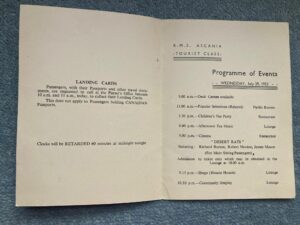
However, after five years she missed her Plymouth home and obviously returned on Ascania via Liverpool.
“She was the couple’s business brain. She owned guest houses, holiday apartments and rented properties. While Chair of Plymouth Conservative Association, she met PM Margaret Thatcher,” said Claire.
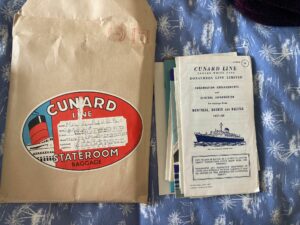 “My grandma went over to visit Doris in Canada and left her fur coat there. It had to be sent back (on Cunard’s RMS Saxonia see left) via Liverpool’s Adelphi Hotel as she had dollars sewn into the lining!”
“My grandma went over to visit Doris in Canada and left her fur coat there. It had to be sent back (on Cunard’s RMS Saxonia see left) via Liverpool’s Adelphi Hotel as she had dollars sewn into the lining!”
What a story packed with human interest (and this is just the bare bones), revealed by just a handful of hidden items. My thanks to Claire Rider for sharing this family tale.
Shipnerd Notes:
ALTHOUGH RMS Ascania was only a small second-tier Cunard liner, she had as distinguished a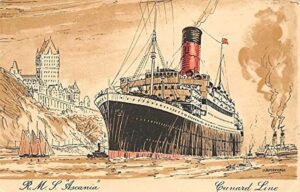 wartime record as her master on this voyage Capt J Crosbie Dawson, DSC. Ascania served as a Battle of the Atlantic convoy escort ship, an infantry landing ship at the invasions of Sicily, Anzio and South of France, and finally as a troopship during the Suez Crisis.
wartime record as her master on this voyage Capt J Crosbie Dawson, DSC. Ascania served as a Battle of the Atlantic convoy escort ship, an infantry landing ship at the invasions of Sicily, Anzio and South of France, and finally as a troopship during the Suez Crisis.
Built by Armstrong Whitworth’s on the Tyne in 1925 as the fifth of Cunard’s six ‘A Class’ ocean liners, in peacetime the 14,013 gross ton vessel spent her time on the UK-Canada run, latterly as here on Liverpool – Quebec – Montreal sailings, with occasional forays to New York.
An ex-Cunard purser Charlie Sutherland told me that during a lifeboat drill aboard Cunard’s giant superliner RMS Queen Mary – while berthed in New York – Ascania came alongside. As she did so a joker onboard Queen Mary with a megaphone yelled: “You’ve not been out all night in that have you?!”
Charlie said: “There was a hell of a row, but they never found out the culprit!”
At the time of the voyage described above Ascania’s capacity was 200 First and 500 Tourist Class passengers. She was broken up in Newport, South Wales, in 1957.

